#eBook development guide
Explore tagged Tumblr posts
Text
A Writer's Journey - Discover The Steps To Writing An eBook That Stands Out
Creating an outstanding eBook requires a strategic approach and dedication to quality content. Follow a structured writing process to ensure your eBook captures and retains reader attention.
Embarking on the journey of writing an eBook can be both exciting and daunting. The key to success lies in the ability to distinguish your work amidst a sea of digital content. This requires not only a compelling topic that resonates with your target audience but also a clear, concise writing style underpinned by thorough research and planning.
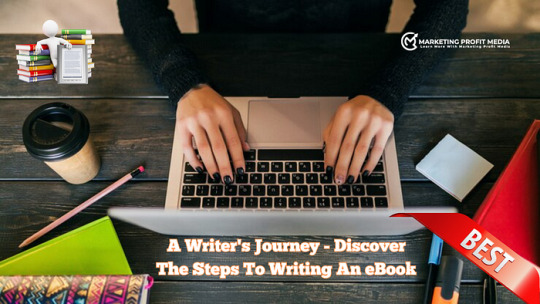
>> My Best Recommended & Proven Way to Make $100 Daily — Watch THIS Video FREE Training to START >>
Embarking On The Ebook Odyssey
Writing an ebook is an adventure, a creative journey transforming ideas into digital pages. It’s a quest that demands courage, commitment, and clarity. With each chapter, writers navigate the vast sea of digital publishing to deliver a work that connects, informs, and entertains.
Personal Motivations And Goals
Every writer embarks on their ebook journey for unique reasons. Some seek to share expertise or stories, while others chase the dream of becoming a published author. Understanding personal motivations clarifies purpose and fuels perseverance.
Sharing knowledge — Educate readers on a specific topic.
Telling stories — Captivate audiences with compelling narratives.
Building authority — Establish expertise in a chosen field.
Generating income — Create a passive revenue stream.
Fulfilling aspirations — Realize the goal of publishing a book.
Identifying goals is crucial. Clear goals navigate the writing process and shape the ebook’s path to success.
The Rising Popularity Of Ebooks
The digital revolution has made ebooks incredibly popular. Their convenience and accessibility have revolutionized reading habits globally.
Ebook AdvantagesImpact on ReadersPortabilityCarry a library on a deviceCost-effectiveOften cheaper than print booksInteractiveLinks, audio, and video enhance experienceEco-friendlyNo paper used, reducing environmental impact
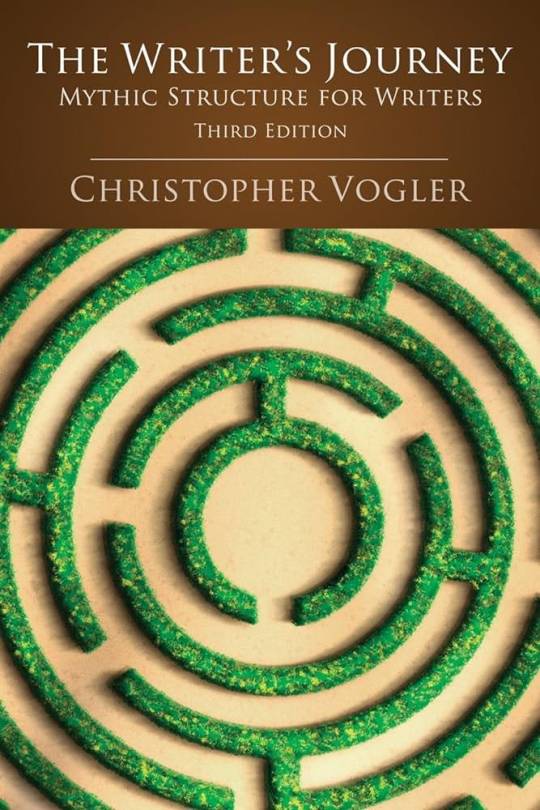
Credit: www.amazon.com
Crafting The Ebook Concept
Crafting the Ebook Concept is a foundational step on a writer’s journey to producing an ebook that truly stands out. This crucial phase involves deep thinking and strategic planning to ensure your ebook resonates with readers and achieves its purpose. From selecting a topic that sparks interest to understanding your target audience and analyzing the market, this stage sets the trajectory for your ebook’s success.
Selecting A Captivating Topic
Selecting the right topic is pivotal. It ignites curiosity and encourages downloads. Follow these tips to pinpoint a subject that captivates:
Identify your passions: Write about what excites you.
Know your strengths: Choose a topic that showcases your expertise.
Uncover gaps: Seek out areas with limited resources.
Check trends: Use Google Trends to discover popular themes.
Market Analysis And Audience Targeting
Understanding your market and audience ensures your ebook meets readers’ needs. Here’s a brief guide:
Audience InsightsCompetitive ResearchCollect data on reader demographics, interests, and challenges.Analyze top-performing ebooks in your niche.Create reader personas to target content accurately.Identify content gaps left by competitors.Engage with potential readers through surveys and social media.Review reader feedback on similar ebooks for improvement ideas.
Implement the insights gathered to tailor your ebook to your audience’s preferences. Doing so increases your ebook’s appeal and potential impact.
>> My Best Recommended & Proven Way to Make $100 Daily — Watch THIS Video FREE Training to START >>
Initial Drafting: Laying The Foundation
An author’s first steps in the journey of writing an eBook are crucial. The initial drafting phase is akin to building the base of a house. It must be strong and well-structured. For robust eBook creation, focusing on an outline and cultivating productive writing habits are essential. Let’s explore how to craft this essential groundwork. With a clear outline and consistent writing routines, your eBook will start to take shape, firmly standing on the foundation you lay.
Outlining Your Ebook
Outlining your eBook acts as a blueprint for your writing adventure. Start with brainstorming key ideas and categorize them into chapters. Organize thoughts and research into a logical flow. Below are steps to create an effective outline:
Identify the main theme of your eBook.
Break down the theme into subtopics or chapters.
Arrange chapters in a coherent, engaging order.
Detail each chapter with bullet points of key concepts.
Refine the outline by reviewing and rearranging as needed.
Writing Rituals And Routines
Consistency transforms ordinary tasks into extraordinary achievements. Establishing writing rituals and routines is the engine that will power you through the drafting process. Consider these tips:
Select a specific time of day for writing.
Set achievable daily word count targets.
Create a comfortable, distraction-free writing space.
Commit to regular short breaks to maintain focus.
Track your progress and adjust goals accordingly.
Remember, structured routines lead to sustainable writing habits. Every word you write builds the foundation of your eBook, paving the way to success. Embrace these initial drafting steps and watch as your eBook begins to take life!
Refining Your Draft
Imagine your ebook as a diamond in the rough. Refining your draft shapes this gem into its final, sparkling glory. This key phase in your writing journey involves honing your manuscript with precision. It requires self-editing techniques and beta reader feedback to elevate the quality of your work. Grab your polishing tools; let’s make your ebook dazzle on the digital shelves!
Self-editing Techniques
Transform your first draft into a polished masterpiece by mastering self-editing. Aim for clarity, coherence, and conciseness throughout your ebook.
Read Aloud: Spot clumsy phrasing and awkward dialogue easily.
Check Consistency: Ensure character details and plot points remain constant.
Look for Overused Words: Replace repetitions with synonyms for variety.
Simplify Complex Sentences: Short, direct sentences bring clarity.
Focus on Flow: Transition smoothly between topics and chapters.
Grammar and Spell Check: Use tools like Grammarly to correct basic errors.
After self-revisions, your draft should feel tighter and more engaging.
Incorporating Beta Reader Feedback
External perspectives shed light on areas you might have overlooked. Beta readers provide invaluable feedback before your final edit action.
Choose the Right Readers: Select individuals from your target audience.
Provide Clear Instructions: Ask specific questions about your book.
Analyze Feedback: Identify common trends in the comments received.
Prioritize Changes: Tackle major issues before minor adjustments.
Update Your Draft: Apply changes that align with your book’s vision.
Beta reader insights can dramatically improve your ebook’s effectiveness and reader appeal.
By harnessing both self-editing techniques and beta reader insights, your ebook will shine brilliantly among its peers. Your writing journey edges closer to a successful publication with every careful revision. Put in the effort during this phase, and readers will notice the professionalism and care infused into your work.
Professional Touch: Editing And Cover Design
To stand out in the vast sea of ebooks, your masterpiece needs a professional touch. Transforming a good ebook into a great one demands meticulous editing and a cover that captures attention. Let’s delve into how these essential elements elevate your ebook’s appeal.
Hiring An Editor
Polished content reflects your professionalism. A skilled editor fine-tunes your ebook, ensuring clarity and coherence. An editor also brings fresh perspectives, catching subtle grammatical nuances that may bypass your keen eyes. Let’s break down the editing process:
Developmental Editing: This phase refines your ebook’s structure and flow.
Copy Editing: Here, your grammar, spelling, and punctuation get scrutinized.
Proofreading: The final look before publishing, this step irons out lingering errors.
Selecting the right editor can be a game-changer for your ebook’s success. Opt for professionals who align with your vision and writing style.
Designing An Eye-catching Cover
First impressions count, and your ebook’s cover is crucial. A striking cover beckons potential readers, hinting at the adventure within. Key elements to consider:
Use bold colors and legible typography that align with your content.
Ensure your imagery is high-quality and relevant to your ebook’s theme.
Keep it simple: Avoid clutter. A clean, professional look is key.
For those not well-versed in design, commissioning a graphic designer is a smart move. They can craft a cover that embodies your ebook’s essence while also being visually compelling.
Remember, your cover is your storefront — make it count!
>> My Best Recommended & Proven Way to Make $100 Daily — Watch THIS Video FREE Training to START >>
Preparing For Ebook Launch
The journey of writing an ebook culminates in its launch, a pivotal moment that requires precise preparation and strategy. This critical phase determines the reach and impact of your work. Embrace these steps for a launch that not only grabs attention but also sustains interest in the literary market.
Building An Online Presence
Establishing a digital footprint is essential for modern authors. Start by creating an author website with a memorable domain name. Use it to share your story and connect with readers.
Engage on social media. Choose platforms where your target audience loves to hang out.
Post regularly on your blog. It should offer valuable content, not just book promotions.
Network with other authors and industry influencers. Consider collaborations for broader reach.
Developing A Marketing Strategy
Having an actionable plan is crucial. Start by identifying your core audience. Who will love your book the most? Craft a message that speaks to them directly.
Design attractive graphics for promotions. Use tools like Canva.
Schedule an official book launch event. It could be online or in a local bookstore.
Collect email addresses for direct marketing campaigns. Offer an ebook teaser for sign-ups.
Utilize early reviews to build anticipation. Reach out to book bloggers and offer a free copy in exchange for an honest review.
Marketing Timeline for Ebook LaunchTimeframeAction6 Weeks BeforeFinalize book cover and description.4 Weeks BeforeSend press releases to media outlets.2 Weeks BeforeBegin countdown on social media.Launch DayHost live Q&A session with readers.
Post-launch: Maintaining Momentum
The thrill of publishing an ebook doesn’t end at launch. Keeping the momentum is key. You’ve crossed the finish line, but the race goes on. Smart strategies post-launch can make your ebook a continued success. Let’s explore how to sustain the buzz!
Gathering And Utilizing Reviews
Reviews are your ebook’s best friends. They build trust and provide social proof. Positive feedback propels more sales. It’s like a chain reaction.
Ask readers for reviews right after they finish the ebook.
Use email campaigns to remind buyers to leave their thoughts.
Showcase top reviews on your website and social media.
Respond to feedback, even the negative, to show you care.
Treat reviews as gold. Use them to refine your writing. They can guide your next project.
Planning Your Next Writing Project
Don’t let the momentum fade. Start planning your next ebook. Use insights from your recent launch to make the next one even better.
TaskActionAnalyze what workedCheck which marketing efforts brought the best results.Look at reader feedbackConsider what readers loved and what they wanted more of.Set goals for the next bookBe specific about what you want to achieve.
Keep your writing muscle active. Start brainstorming. Outline ideas. Dive into the next adventure.
Growth is continuous. So is the journey of a writer. Keep learning, keep improving, keep writing.
Frequently Asked Questions
What Is An Ebook?
An ebook is a digital book format that readers can access on electronic devices such as computers, tablets, or smartphones.
Why Write An Ebook?
Writing an ebook allows authors to easily share and distribute their work globally, target specific audiences, and often, self-publish.
How To Start Writing An Ebook?
Begin by choosing a compelling topic, create an outline, and dedicate time for consistent writing to maintain progress on the ebook.
What Makes An Ebook Stand Out?
A unique perspective, engaging content, exceptional value to the reader, and professional formatting are key elements that make an ebook stand out.
Tips For Marketing An Ebook?
Effective ebook marketing strategies include building an email list, leveraging social media platforms, and getting reviews to enhance credibility and visibility.
Conclusion
Embarking on an ebook creation journey marks the beginning of an exciting adventure for any writer. By following the steps outlined, your book can shine amidst a sea of digital content. Remember, crafting an engaging narrative and providing unique insights will captivate readers and set your work apart.
Keep honing your skills, stay true to your voice, and the path to a standout ebook is yours to claim.
>> My Best Recommended & Proven Way to Make $100 Daily — Watch THIS Video FREE Training to START >>
Thanks for reading my article on A Writer’s Journey — Discover The Steps To Writing An eBook That Stands Out, hope it will help!
Affiliate Disclaimer :
This article Contain may be affiliate links, which means I receive a small commission at NO ADDITIONAL cost to you if you decide to purchase something. While we receive affiliate compensation for reviews / promotions on this article, we always offer honest opinions, users experiences and real views related to the product or service itself. Our goal is to help readers make the best purchasing decisions, however, the testimonies and opinions expressed are ours only. As always you should do your own thoughts to verify any claims, results and stats before making any kind of purchase. Clicking links or purchasing products recommended in this article may generate income for this product from affiliate commissions and you should assume we are compensated for any purchases you make. We review products and services you might find interesting. If you purchase them, we might get a share of the commission from the sale from our partners. This does not drive our decision as to whether or not a product is featured or recommended.
Source : A Writer’s Journey — Discover The Steps To Writing An eBook That Stands Out
#Writer's journey#eBook writing process#Crafting an eBook#Writing journey tips#eBook creation steps#Authoring journey insights#eBook development guide#Writing an eBook blueprint#Publishing your eBook#Self-publishing tips#eBook authoring steps#Writing journey strategies#eBook writing techniques#Crafting a standout eBook#Authoring journey advice#eBook creation roadmap#Writing an eBook process#Publishing strategies for eBooks#Self-publishing essentials#eBook authoring insights#Writing journey roadmap#eBook writing guidance#Crafting a compelling eBook#Authoring journey roadmap#eBook creation tips#Affiliate Earnings#Affiliate Marketing#Affiliate Marketing Guide#Affiliate Marketing Mastery#Blogging
1 note
·
View note
Link
#Business Coaching#eBooks#Financial Coaching#FromZero2Hero#Guided Meditation#Journaling#Life Coaching#Personal Development#Personal Growth#Personal Planning#YEVL Pty Ltd
0 notes
Text
TRY-The Real You webpage guide
https://www.try-therealyou.co.za/ TRY-The Real you is my newest baby. The website has many beautiful teachings on how to become a better version of you. A you that reaches for your dreams and fights a tough fight to push through everything that stands in your way. This page is not limited to only people living in South Africa. It is set up so that you who live internationally can have access to…
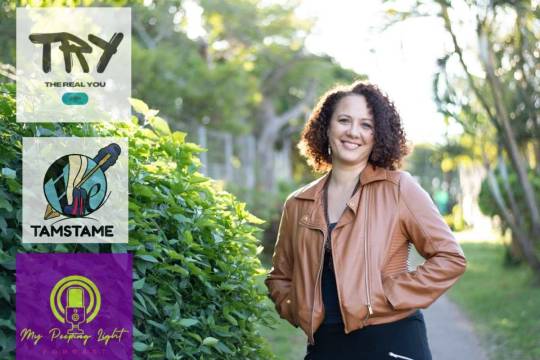
View On WordPress
#Believe in yourself#beyourbest#eBooks#Guided Study#Life Courses#self development#Self Discovery#Self Study#tamstame#Try The Real You
0 notes
Text
Leadership: Navigating the Path to Excellence
This ebook provides a comprehensive exploration of leadership concepts, styles, and practices, offering readers valuable insights into becoming effective, influential leaders in various contexts. Each chapter offers practical strategies, real-world examples, and thought-provoking questions to encourage self-reflection and personal growth on the leadership journey. Chapter 1: Introduction to…

View On WordPress
#book#book club#business#development#ebook#excellence#guide#improvement#leadership#senior management#success#training
0 notes
Text
📊 How to Use Tropes Without Turning Your Story into a YA Checklist
You can tell when a book was written by vibes and TVTropes alone.
It’s got: ☑️ the reluctant chosen one ☑️ the love triangle ☑️ the mysterious brooding boy™ ☑️ the sassy best friend ☑️ the dead parents ☑️ the villain with daddy issues ☑️ the scene where someone says “you don’t know what I’m capable of” and walks away dramatically
And like… that’s fine.
Tropes are tools. But here’s the thing: they are starting points, not story goals.
If your plot reads like it was drafted by a checklist in a Pinterest caption, it might be time to recalibrate. Here's how to actually use tropes without turning your book into a YA Mad Libs generator:
─────── ✦ ───────
🧩 Tropes Are Patterns--Not Presets
A trope is a pattern, not a requirement. It’s not a law. It’s not a plug-and-play feature. And it’s definitely not your plot.
The “enemies-to-lovers” arc? That’s a container. What you put inside it, that’s where the originality lives.
The goal isn’t to avoid tropes. It’s to do something interesting with them.
→ Why are they enemies? → What does the “love” cost them? → What happens if they fail to become lovers?
Tropes don’t carry the story. The conflict does.
─────── ✦ ───────
⚔️ Complicate the Familiar
Here’s a trick: if a trope feels too easy, break it in half.
Examples: → “Reluctant chosen one” → okay, but what if they wanted it, and then hated it once they got it? → “The mentor dies” → cool, but what if the mentor fakes their death to manipulate the protagonist? → “Sassy best friend” → no. Make them real. Give them pain. Give them depth. No more walking punchlines.
Tropes are scaffolding, not shortcuts. Add weight. Add doubt. Add betrayal.
─────── ✦ ───────
🕳️ Interrogate Why You’re Using It
Ask yourself: → Do I love this trope or do I feel like I have to include it? → Am I doing this because I’ve seen it done… or because it serves my story? → Is this trope the only interesting thing about this scene?
If your answer is “because that’s what YA stories do,” delete it. Go deeper.
─────── ✦ ───────
💔 Tropes Aren’t Substitutes for Character Arcs
You can’t use “grumpy x sunshine” and call it development. Tropes are flavors, not meals.
Give us: → Choices with consequences. → Conflicting values. → Character growth that costs something.
Otherwise? Your grumpy guy is just a Pinterest moodboard with a pulse.
─────── ✦ ───────
🧨 Use Reader Expectations Against Them
You want to use a trope and not make it predictable? Weaponize it.
Example: → Start with a love triangle. Let the MC fall hard. Then have both love interests realize they’re in love with each other. → Use the “chosen one” trope… but make it about dismantling that myth entirely. → Introduce the “villain redemption arc” and let them choose to stay bad because it makes more sense for them.
Set up the pattern. Then snap it in half. That’s how you surprise a jaded reader.
─────── ✦ ───────
Final thoughts from your local trope goblin:
→ Tropes aren’t the problem. It’s treating them like a checklist instead of a narrative engine. → A good trope doesn’t make your story good. How you twist it does. → If a story reads like it was built from Tumblr quotes and nothing else—it’s gonna flop.
So go ahead. Use the trope. Then ruin it. Make it weird. Make it hurt. Make it yours.
—rin t. // story mechanic. trope thief. YA bingo card burner. // thewriteadviceforwriters
Sometimes the problem isn’t your plot. It’s your first 5 pages. Fix it here → 🖤 Free eBook: 5 Opening Pages Mistakes to Stop Making:
🕯️ download the pack & write something cursed:
#writing#writing advice#writeblr#writers on tumblr#writing tips#writing help#how to write#story structure#writing process#plotting tips#writing guide#writing blog#writing community#writing support#tumblr writing community#writing inspiration#storytelling tips#how to outline#writing resources#novel writing#outline tips#plotting a novel#writing craft#novel planning#write a book#drafting a novel#writing motivation#first draft advice#fiction writing#character arcs
216 notes
·
View notes
Text
curating reading lists (without social media)
a guide to finding stuff to read, for @divorceblogger. this is a guide specifically for avoiding things like goodreads/storygraph etc which aggregate books that are popular without being all that helpful for finding things on niche/specialist topics.
a bit of housekeeping before getting to the actual list-making tips:
i mostly read nonfiction targeted at both academic and popular audiences. i also read a mixture of classic lit, genre fiction, zines & conceptual/artists’ books, and playtexts & poetry. i read traditional print books, non-traditional print publications, PDF and ePub ebooks on an iPad/iPhone, and listen to audiobooks and audio dramas.
i have a infinite number of books i want to read. the discovery process of new & interesting outstrips my capacity to read them all, so i have to be extremely selective. this also means i never tolerate a book i’m not enjoying. it can have weak points, but i have to be getting something out of the experience, or else i am wasting my one wild n precious life, ya feel?
my goal is to read for quality, not for quantity. i tend to dislike a lot of online reading communities for their focus on metrics (number of books, page count, word count, etc). i bristle at tools that try to push my reading into this direction. i have a reading practice, in the same sense that one would have an artistic practice. thinking of my reading as a practice — rather than a project, a thing to be completed and checked off the checklist — helps orient me towards patterns of thinking that serve me better
i work in the arts industry, so fiction and non-fiction books are reference tools. when I finish reading a book, I put it back on the shelf, like returning a tool to the toolbox until it is time to use it again. i live in a bachelor flat, so obvs i have to resist the incessant pressures of consumerism, but it doesn’t bother me that i have not read every book that i own. they are there for when i get to them. similarly, i would not be bothered by owning a kitchen fire extinguisher that i have not used.
where do I keep my reading lists?
Obsidian: for organising to-read lists on specific topics, genres, eras, locations, etc. i repeat books across multiple lists where appropriate. i don’t keep a single master list of everything I want to read because it would simply be too unwieldy to manage. Small focused lists of no more than ~25 books on the topic are best, imo.
TinyCat: for cataloguing physical books that i own. i have a shortcut to the website on my phone so i can easily pull it up if i can’t remember what books in a series i already have. i can tag anything unread with my “antilibrary” tag. for my own amusement, i also insert library pockets and circulation cards into my books and stamp them with the date completed (using my beloved rotary date stamp). i can also stamp the date a friend who borrowed the book completed it. i like seeing the signatures add up over time.
Zotero: for academic bibliographic citations. useful habit to get into if you transcribe lots of quotes from yr readings into yr notes.
how do i develop my reading lists?
i usually develop my reading lists through a combination of concerted effort to research a topic & ambient browsing. this isn’t Abt How to rigorously conduct research though so im gonna focus more on ~letting books organically find me~
when i have a book that i enjoy, i see if the author has written any more books on topics that interest me. incredibly basic 101 advice but somehow people still miss this one.
check the bibliographies & acknowledgements. if something comes up in bibliography after bibliography, its usually a good sign its worth checking out. also, authors usually thank other authors in their acknowledgements, its a great way to start building an idea
i love when artists talk abt their influences in interviews, like this interview abt what influences and easter eggs there are in disco elysium (i screamed at the Einstürzende Neubauten reveal!!!). i love when fans come up with their own reading lists for media, like my list speculating what daniel molloy would have read and watched in 1973.
when i am travelling somewhere i try to read something related to the to place I am going. Wikipedia is a first easy point of reference to find out if yr destination is famous for being the birthplace of X poet or Y film is set there.
tertiary sources. secondary sources are about a primary source, whereas tertiary sources aim to provide an overview of the major debates in those secondary sources on a specific topic rather than to generate their own new ideas/arguments. the oxford university press “a very short introduction” series varies in quality but its often a very useful starting point.
recs from friends/gifts. my loved ones know i like books, and books are usually a cheap & easy gift for holidays & special occasions. i gift books that i want to read myself, so we can talk abt the book together.
what physical locations do I browse?
Local library, university library. You might be even be able to get a specialist library card to an archive or museum reading room. Some public libraries also have special collections like the Seattle Zine Library.
For-sale section in the local library. proceeds usually go to supporting the library
local secondhand bookshop. there are several in walking distance, i usually hit them up quarterly, especially as i gift a lot of secondhand books
local independent bookshops. several local independent bookstores host an annual bookstore crawl where if you get a stamp from all of them in one weekend u enter a draw to win $1000 gift card :)
thrift store/charity shop/antique markets. there is usually a section with books even if the main focus is clothes/furniture
book events. author talks, staged readings of new plays, poetry readings, book/lit mag launch parties, Writers Festivals, small/independent press fair, rare book fair, zine fests, international library day, conferences
bookshelves at house parties. im 100% the person checking out yr bookshelf at a house party. great place to get yr flirt on.
travel. basically any new place im going, i look-up in advance the local library, second hand bookstores, charity shops, antiques stores etc. and save them in my maps on my phone. if i can conveniently pop into one while im there, neat! i particularly like municipal libraries bc the big ones are usually architecturally interesting (like the Vancouver Public Library) and the small ones are usually really charming and full of specific local history, leaflets to interesting local stuff, etc.
what online locations do I browse?
navigating the online catalogue to yr local & academic libraries is a whole skill unto itself. i was very fortunate be born in the late 90s and to have a specific local librarian teach me boolean operators before i could tie my shoelaces, ride a bike, or, frankly, do most human being things (shoutout to Miss T yr a real one). your library very likely has something like a workshop or at the very least a help desk that can help u with this if needed.
mailing lists of small/independent presses.
publishers websites (academic and general audience).
wikipedia. u can look at the footnotes section on wikipedia. its free. its legal.
looking up university syllabi. some are on profs’ websites, some are available through the university library. there is also the Open Syllabus website which aggregates the most often mentioned books in submitted syllabi, organised by discipline or through a visual map.
what’s available on libby/borrowbox.
Archive dot org and google books/google scholar to read the previews and judge if the book is worth following up on.
i didn’t actually include any selections of my personal reading lists, but if you would like to know more you can always shoot me an ask with a specific topic in mind.
161 notes
·
View notes
Text
High Value Woman Formula: The 4 Key Pillars

Are you passionate about leveling up, but find yourself daunted by the overwhelming list on how to become a high value woman?
Don’t fret, you’re probably not the only one! It may sound complicated at first glance, but when you truly understand what it’s about, the high value woman formula is… quite simple.
In this article, I will show you an easy and concise roadmap to becoming the woman of your own dreams.
Let’s get started.
Pillar #1: Body

Much like Maslow’s pyramid, in order to have a mind that is clear, a heart that is at peace, and a soul that is fulfilled, you need to first attend to your basic physical needs (and not only).
Getting enough hours of sleep
A healthy diet
Fitness & exercise
Haircare
Nails
Skin
Dental health
Make-up
Pillar #2: Mind

Next ingredient in the high value woman formula is polishing your mind.
Upgrading your looks and physical health is great, but if you don’t follow it up with a mindset glow up, you’ll find yourself repeating the same mistakes, and bumping into the same limiting beliefs and bad habits.
Planning goals and keeping track of them
Improving your mindset / develop a growth mindset
Confidence
Embrace failure
Reading extensively to broaden your mind and your education (includes financial education)
Courses, trainings and masterclasses
Listening to podcasts
Watching TedTalks or insightful documentaries (if you’re curious about my recs for TedTalks/documentaries, let me know in comments below)
Pillar #3: Heart

So you’ve leveled up your appearance, improved your mind, now what? Now it’s all about your heart and your emotions. Think about all the things that nurture your emotional dimension and makes you feel appreciated, seen and heard!
Building a support system (friends, family, therapy)
Therapy
Healing your attachment style
Journaling
Self Love
Setting boundaries
Being your authentic self
Speaking your truth
Embracing your journey
Feeling & processing your emotions
Pillar #4: Soul

Last but not least, I’m a spiritual woman, and these are my personal beliefs which some may or may not resonate with. If that’s the case and you’re happy with just the 3 first pillars, that’s perfectly valid and you can skip this section.
But I do believe you have to take care of your soul. You can have the looks, the money and your self-concept in line, but you might still feel empty, unfulfilled, like something is missing from your life… if you ignore the spiritual aspect.
For the girlies that need a deeper connection to the divine, to God, the universe, here are a few action steps.
Joining a community that resonates with you
Prayer
Yoga
Meditation
Various spiritual practices that align with your beliefs
Detoxing from social media, toxic people or environments
Conclusion
What do you think about this list, did you find it helpful? Are there any essentials you’d add to the list? Let me know in the comments below.
This is a topic I believe many women (and not only) would benefit from, and I’m passionate about helping my readers become their best selves.
So, I’m currently working on an in-depth guide that expands on this topic/article, complete with practical steps you can implement in your daily life, in order to become a High Value Woman.
💖 If you want to be the first to hear about the HVW ebook's launch make sure to join my Soultribe! 💖
🎀 More glow up articles and guides on sklumen.com 🎀
#high value woman#femininity tips#hypergamy#level up journey#self development#personal excellence#high standards#high maintenance#glow up tips#level up#becoming that girl#it girl#clean girl#that girl#it girl energy#articles#blog
102 notes
·
View notes
Text
Creating a personal fanfic archive using Calibre, various Calibre plugins, Firefox Reader View, and an e-Reader / BookFusion / Calibre-Web
A few years ago I started getting serious about saving my favorite fic (or just any fic I enjoyed), since the Internet is sadly not actually always forever when it comes to fanfiction. Plus, I wanted a way to access fanfic offline when wifi wasn't available. Enter a personal fanfic archive!
There are lots of ways you can do this, but I thought I'd share my particular workflow in case it helps others get started. Often it's easier to build off someone else's workflow than to create your own!
Please note that this is for building an archive for private use -- always remember that it's bad form to publicly archive someone else's work without their explicit permission.
This is going to be long, so let's add a read more!
How to Build Your Own Personal Fanfic Archive
Step One: Install Calibre
Calibre is an incredibly powerful ebook management software that allows you to do a whole lot of stuff having to do with ebooks, such as convert almost any text-based file into an ebook and (often) vice-versa. It also allows you to easily side-load ebooks onto your personal e-reader of choice and manage the collection of ebooks on the device.
And because it's open source, developers have created a bunch of incredibly useful plugins to use with Calibre (including several we're going to talk about in the next step), which make saving and reading fanfiction super easy and fun.
But before we can do that, you need to download and install it. It's available for Windows, MacOS, Linux, and in a portable version.
Step Two: Download These Plugins
This guide would be about 100 pages long if I went into all of the plugins I love and use with Calibre, so we're just going to focus on the ones I use for saving and reading fanfiction. And since I'm trying to keep this from becoming a novel (lolsob), I'll just link to the documentation for most of these plugins, but if you run into trouble using them, just tag me in the notes or a comment and I'll be happy to write up some steps for using them.
Anyway, now that you've downloaded and installed Calibre, it's time to get some plugins! To do that, go to Preferences > Get plugins to enhance Calibre.
You'll see a pop-up with a table of a huge number of plugins. You can use the Filter by name: field in the upper right to search for the plugins below, one at a time.
Click on each plugin, then click Install. You'll be asked which toolbars to add the plugins to; for these, I keep the suggested locations (in the main toolbar & when a device is connected).
FanFicFare (here's also a great tutorial for using this plugin) EpubMerge (for creating anthologies from fic series) EbubSplit (for if you ever need to break up fic anthologies) Generate Cover (for creating simple artwork for downloaded fic) Manage Series (for managing fic series)
You'll have to restart Calibre for the plugins to run, so I usually wait to restart until I've installed the last plugin I want.
Take some time here to configure these plugins, especially FanFicFare. In the next step, I'll demonstrate a few of its features, but you might be confused if you haven't set it up yet! (Again, highly recommend that linked tutorial!)
Step Three: Get to Know FanFicFare (and to a lesser extent, Generate Cover)
FanFicFare is a free Calibre plugin that allows you to download fic in bulk, including all stories in a series as one work, adding them directly to Calibre so that that you can convert them to other formats or transfer them to your e-reader.
As with Calibre, FanFicFare has a lot of really cool features, but we're just going to focus on a few, since the docs above will show you most of them.
The features I use most often are: Download from URLs, Get Story URLs from Email, and Get Story URLs from Web Page.
Download from URLs let's you add a running list of URLs that you'd like FanFicFare to download and turn into ebooks for you. So, say, you have a bunch of fic from fanfic.net that you want to download. You can do that!
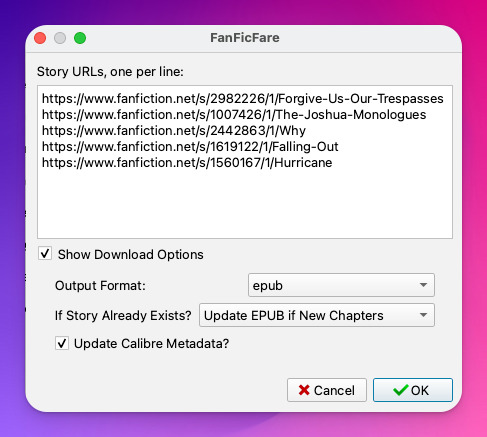
Now, in this case, I've already downloaded these (which FanFicFare detected), so I didn't update my library with the fic.
But I do have some updates to do from email, so let's try getting story URLs from email!
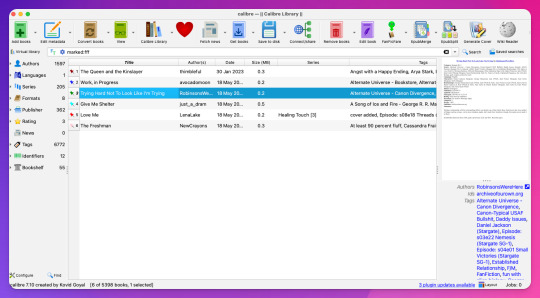
Woohoo, new fic! Calibre will detect when cover art is included in the downloaded file and use that, but at least one of these fic doesn't have cover art (which is the case for most of the fic I download). This is where Generate Cover comes in.
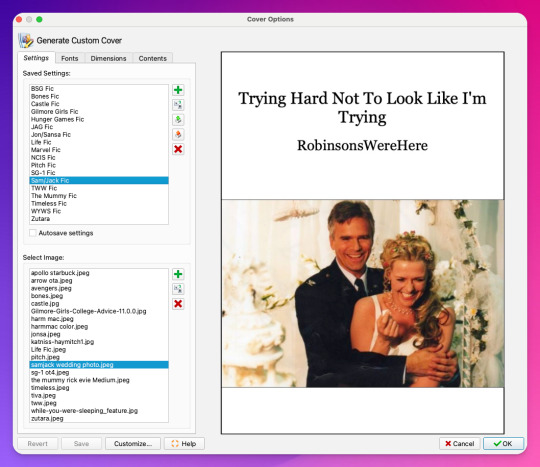
With Generate Cover, I can set the art, font, dimensions, and info content of the covers so that when I'm looking at the fic on my Kindle, I know right away what fic it is, what fandom it's from, and whether or not it's part of a series.
Okay, last thing from FanFicFare -- say I want to download all of the fic on a page, like in an author's profile on fanfic.net or all of the stories in a series. I can do that too with Get Story URLs from Web Page:
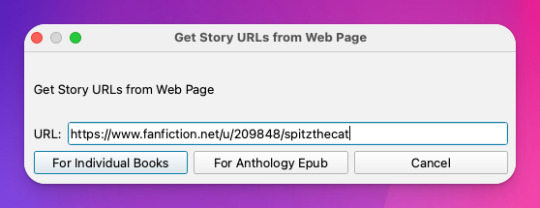
The thing I want to call out here is that I can specify whether the fic at this link are individual works or all part of an anthology, meaning if they're all works in the same series, I can download all stories as a single ebook by choosing For Anthology Epub.
Step Four: Using FireFox Reader View to Download Fic Outside of Archives
This is less common now thanks to AO3, but the elders among us may want to save fanfic that exists outside of archives on personal websites that either still exist or that exist only on the Internet Wayback Machine. FanFicFare is awesome and powerful, but it's not able to download fic from these kinds of sources, so we have to get creative.
I've done this in a couple of ways, none of which are entirely perfect, but the easiest way I've found thus far is by using Firefox's Reader View. Also, I don't think I discovered this -- I think I read about this on Tumblr, actually, although I can longer find the source (if you know it, please tell me so I can credit them!).
At any rate, open the fic in Firefox and then toggle on Reader View:
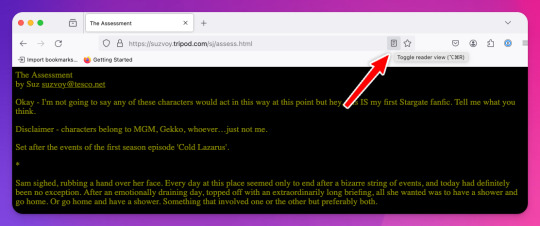
Toggling on Reader View strips all the HTML formatting from the page and presents the fic in the clean way you see in the preview below, which is more ideal for ebook formats.
To save this, go to the hamburger menu in the upper right of the browser and select Print, then switch to Print to PDF. You'll see the URL and some other stuff at the top and bottom of the pages; to remove that, scroll down until you see something like More settings... and uncheck Print headers and footers.
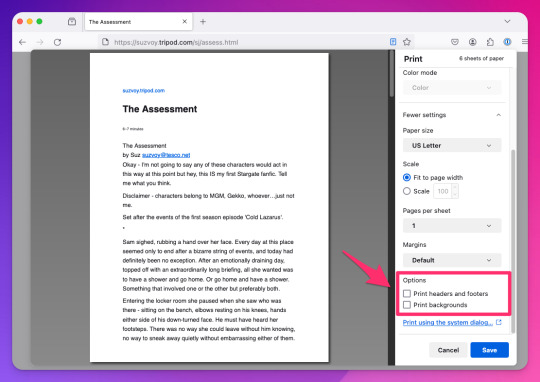
Click Save to download the resulting PDF, which you can then add to Calibre and convert to whichever format works best for your e-reader or archive method.
Step Five: Archiving (Choose Your Own Adventure)
Here's the really fun part: now that you know how to download your fave fanfics in bulk and hopefully have a nice little cache going, it's time to choose how you want to (privately) archive them!
I'm going to go through each option I've used in order of how easy it is to implement (and whether it costs additional money to use). I won't go too in depth about any of them, but I'm happy to do so in a separate post if anyone is interested.
Option 1: On Your Computer
If you're using Calibre to convert fanfic, then you're basically using your computer as your primary archive. This is a great option, because it carries no additional costs outside the original cost of acquiring your computer. It's also the simplest option, as it really doesn't require any advanced technical knowledge, just a willingness to tinker with Calibre and its plugins or to read how-to docs.
Calibre comes with a built-in e-book viewer that you can use to read the saved fic on your computer (just double-click on the fic in Calibre). You can also import it into your ebook app of choice (in most cases; this can get a little complicated just depending on how many fic you're working with and what OS you're on/app you're using).
If you choose this option, you may want to consider backing the fic up to a secondary location like an external hard drive or cloud storage. This may incur additional expense, but is likely still one of the more affordable options, since storage space is cheap and only getting cheaper, and text files tend to not be that big to begin with, even when there are a lot of them.
Option 2: On Your e-Reader
This is another great option, since this is what Calibre was built for! There are some really great, afforable e-readers out there nowadays, and Calibre supports most of them. Of course, this is a more expensive option because you have to acquire an e-reader in addition to a computer to run Calibre on, but if you already have an e-reader and haven't considered using it to read fanfic, boy are you in for a treat!
Option 3: In BookFusion
This is a really cool option that I discovered while tinkering with Calibre and used for about a year before I moved to a self-hosted option (see Option 4).
BookFusion is a web platform and an app (available on iOS and Android) that allows you to build your own ebook library and access it from anywhere, even when you're offline (it's the offline bit that really sold me). It has a Calibre plugin through which you can manage your ebook library very easily, including sorting your fanfic into easy-to-access bookshelves. You may or may not be able to share ebooks depending on your subscription, but only with family members.
Here's what the iOS app looks like:
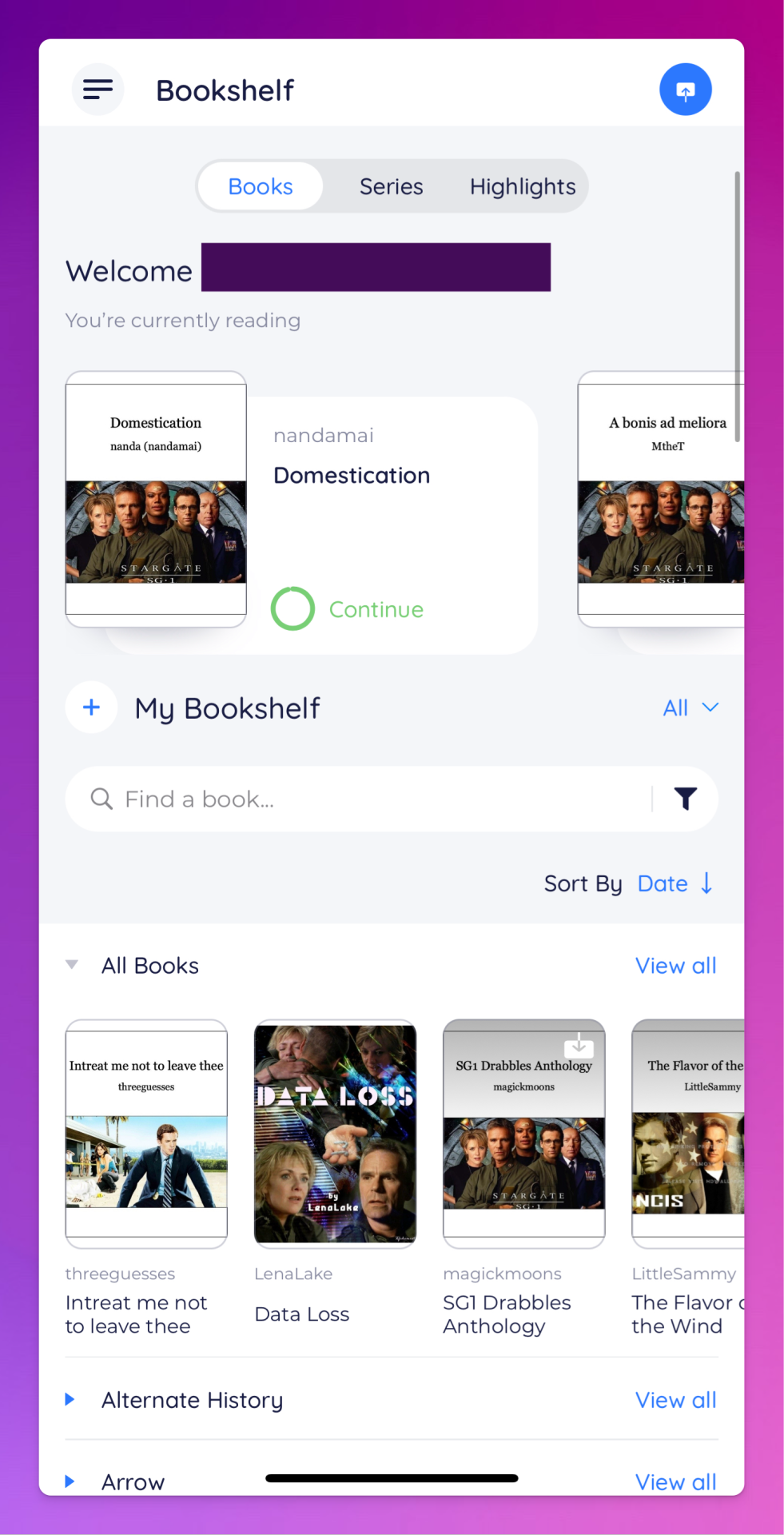
The downside to BookFusion is that you'll need a subscription if you want to upload more than 10 ebooks. It's affordable(ish), ranging from $1.99 per month for a decent 5GB storage all the way to $9.99 for 100GB for power users. Yearly subs range from $18.99 to $95.99. (They say this is temporary, early bird pricing, but subscribing now locks you into this pricing forever.)
I would recommend this option if you have some cash to spare and you're really comfortable using Calibre or you're a nerd for making apps like BookFusion work. It works really well and is incredibly convenient once you get it set up (especially when you want to read on your phone or tablet offline), but even I, someone who works in tech support for a living, had some trouble with the initial sync and ended up duplicating every ebook in my BookFusion library, making for a very tedious cleanup session.
Option 4: On a Self-Hosted Server Using Calibre-Web
Do you enjoy unending confusion and frustration? Are you okay with throwing fistfuls of money down a well? Do you like putting in an incredible amount of work for something only you and maybe a few other people will ever actually use? If so, self-hosting Calibre-Web on your own personal server might be a good fit for you!
To be fair, this is likely an experience unique to me, because I am just technical enough to be a danger to myself. I can give a brief summary of how I did this, but I don't know nearly enough to explain to you how to do it.
Calibre-Web is a web app that works on top of Calibre, offering "a clean and intuitive interface for browsing, reading, and downloading eBooks."
I have a network-attached storage (NAS) server on which I run an instance of Calibre and Calibre-Web (through the miracle that is Docker). After the initial work of downloading all the fic I wanted to save and transferring it to the server, I'm now able to download all new fic pretty much via email thanks to FanFicFare, so updating my fic archive is mostly automated at this point.
If you're curious, this is what it looks like:
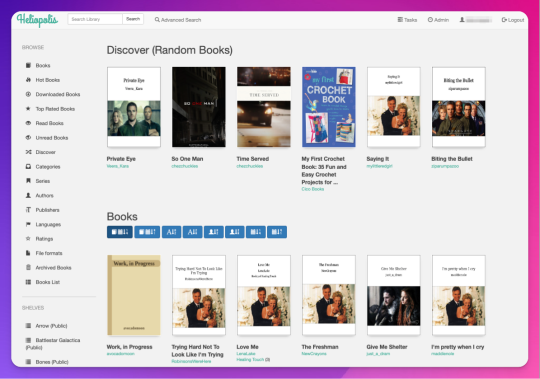
Pros: The interface is clean and intuitive, the ebook reader is fantastic. The Discover feature, in which you are given random books / fic to read, has turned out to be one feature worth all the irritation of setting up Calibre-Web. I can access, read, and download ebooks on any device, and I can even convert ebooks into another format using this interface. As I mentioned above, updating it with fic (and keeping the Docker container itself up to date) is relatively automated and easy now.
Cons: The server, in whichever form you choose, costs money. It is not cheap. If you're not extremely careful (and sometimes even if you are, like me) and a hard drive goes bad, you could lose data (and then you have to spend more money to replace said hard drive and time replacing said data). It is not easy to set up. You may, at various points in this journey, wish you could launch the server into the sun, Calibre-Web into the sun, or yourself into the sun.
Step Six: Profit!
That's it! I hope this was enough to get you moving towards archiving your favorite fanfic. Again, if there's anything here you'd like me to expand on, let me know! Obviously I'm a huge nerd about this stuff, and love talking about it.
#genie's stuff#calibre#calibre-web#bookfusion#personal fanfic archive#archiving fanfic#saving fanfic
103 notes
·
View notes
Text
Mia Winters and the Connections
There are a lot of bad takes on Mia Winters out there, a lot of really irritating shallow misconceptions. But for now, I’m just going to tackle one of the big ones that annoys me the most.
Mia Winters is not a scientist, and it's debatable whether she had any long-term association with the project that created Eveline. She may not have even met Eveline before being assigned to transport her to South America.

Mia’s not any kind of researcher. Her job when she worked at the Connections is laid out clearly in the first document you find within moments of starting the flashback ("Orders"): she’s a member of the Special Operations Division in the English version, or a 'special agent' in the Japanese (特殊工作員, tokushu kousaku-in). The English version also gives Mia the role of 'caretaker', implicitly of Eveline, but there's not much to suggest this is a role extending beyond the bounds of this particular mission (for comparison, the Japanese doesn't mention caretaking at all).
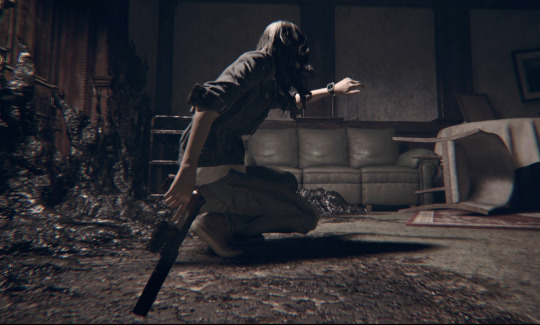
Mia's job is exactly what we see her doing in the game: transporting important assets under cover identities, and running around doing damage control with a machine gun if things go south. She echoes the same in her letter to the Bakers, stating she 'was assigned to transport some important cargo.' Even the 'imprinting protocol' she refers to seems to be mostly part of a transport protocol (going by the very little we ever learn about it), and may not even have been implemented until shortly before they left.
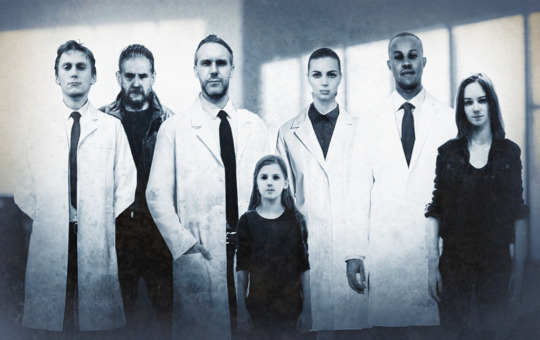
Even in the one photo of her standing with the research team, you might note that Mia and her partner Alan are the only people present not wearing lab coats (and believe me, with how much other photoshopping there is in this photo, Mia would have been wearing a lab coat if they'd wanted her in one). The photo itself is far more of an easter egg than a real plot point anyway, and probably isn't worth reading too much into ‒ I mean, Alan is apparently the director of the Special Operations division, so it makes no sense to assume he's part of this one science team. But if you really want a 'canonical' explanation for this photo, considering Mia and Alan are wearing the same clothes as in the ship flashback, you could reasonably assume it was taken right before Eveline was shipped off to America ‒ a kind of "Let's get one last snapshot of the team together with the transport crew before Eveline goes to South America" deal. It's completely plausible Mia may not even have met Eveline until the same day this was taken.
So where does this 'scientist' nonsense come from? The only source which does call Mia a 'researcher' is a timeline entry in this one RE7 strategy guide which has never been published in English – and it's a good example of why sources like this are usually better treated as pseudo-canon at best. You can find various translations of it online – but you can also buy the whole ebook (which I did), so here's the page where it originally comes up.
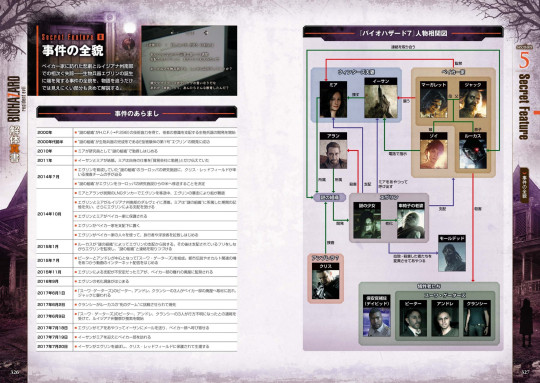
And yes, inasmuch as I’m qualified to translate, the line does state that Mia joined the company as a ‘researcher’ (研究員, kenkyuu-in) in 2010. But the same guidebook also refers to her as an operative (工作員) just a couple of pages later, so even the guidebook is hardly consistent.
Charitably, perhaps we could read that Mia was initially hired as some kind of generic, low-level research assistant before being transferred to the special operations division after showing aptitude in that area. But it's more likely that Mia was simply going to be a researcher at some point in the game’s development history, before Capcom changed their minds, and the timeline that made it into the guidebook is just very out of date ‒ it happens. Either way, one line in an inconsistent guide book hardly trumps what actually made it into the games.
I do realise that asking people to pay attention to what's actually in the games over what's repeated in some wiki somewhere (or a gazillion different fanfic) is a big ask for any fandom, but Mia was clearly never a scientist in the game we all played. She still knowingly worked for some really evil people – she doesn’t get to claim innocence here – but the idea she's personally responsible for every bad thing ever done to Eveline is absurd.

FWIW, other details from the guidebook also back up the idea that transporting assets was a major part of Mia’s job. Her bio (above) mentions that she was away from home a lot, something that strained the Winters’ marriage, and that she told people she worked for a ‘trading company’ – a solid cover for a job focused on travel and logistics.
A very little is said about Mia’s relationship with Eveline. The guidebook does mention that the reason Eveline’s so attached to Mia is because Eveline had known her since she was ‘confined to the “mysterious organisation” that created her’, which could be taken to imply she knew Mia well before their trip began, but it's not much to go on. Mia's own feelings on Eveline are described briefly in a caption: “Although Mia found Eveline creepy, she also felt compassion for her lonely situation,” which tracks with how Mia interacts with her in-game. It doesn't track so well with the idea Mia had any real authority over how Eveline was raised or treated, however, and would be perfectly consistent with the idea Mia might not have known her long at all.
The guidebook timeline also tells us that the E-series project begain in 2000, and that Eveline herself was created in "the early 2000s." This doesn't make a whole lot of sense for reasons I've talked about already, but does put Eveline's creation well before 2010, the year the same timeline gives us for when Mia started working at the Connections. Since the guidebook also tells us Mia was 32 in 2017, back in 2000, she would have been all of 15 years old. Whatever Mia's involvement, the project long predates her joining the company.
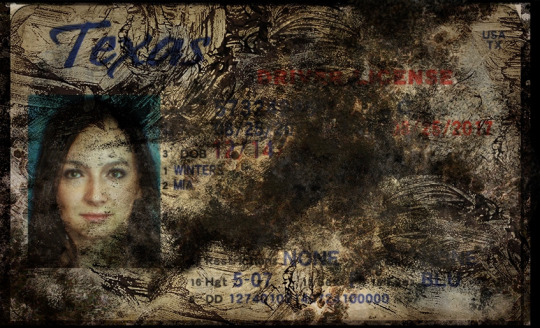
But the real issue with trying to given Mia any major responsibility for the E-series project is that the lab that created Eveline was located in Europe. Mia, meanwhile, has a driver's license telling us she's from Texas.
The European location for the lab is another detail that gets barely mentioned in the games, though it's mentioned repeatedly in the guidebook, and the Baker Incident Report even puts it specifically in Munich, Germany. Given all we learn in RE8, that location does make a lot of sense, when the mould was found in Eastern Europe, and that Miranda herself was part of the research team (she gets multiple photos and a lab coat, you may note). And even if the lab wasn’t right on Miranda’s doorstep, Munich is a heckuva commute from Texas, or anywhere else in the US. Even if Mia was often away from Ethan for long periods, as her bio implies, how involved could she realistically have been?
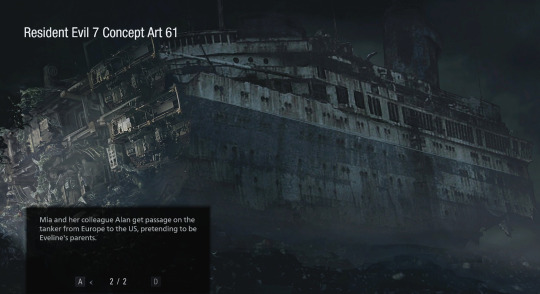
I don't want to overstress the idea that it "doesn't make sense" for a special agent from Texas to have been intimately involved in a European research project ‒ making sense has never held back RE lore before. But the idea that Mia was brought in only as a handler for Eveline when she was being moved to America still makes a lot more sense than to suggest the Connections were fine with their star asset’s primary handler going home to the US every other weekend.
There are possibilities between the two extremes, of course: Mia may have had sporadic contact with Eveline before the trip, either regularly or just once or twice. It's easy to assume the 'imprinting protocol' must mean that Mia's been Eveline's primary handler for some time, but heck, maybe it's better read as the opposite ‒ something that can be quickly applied to a new handler or caretaker in a hurry, to explain how Eveline got so attached to someone she'd only just met.
Given everything we actually see of her, you could even speculate that Mia was chosen as Eveline's 'caretaker' specifically because she was someone nice and motherly enough for Eveline to bond with. Eveline was pretty clearly fucked up long before Mia ever got involved, and not actually wanting to adopt a walking bioweapon whose idea of a happy family involves mould-powered mind control really does not reflect badly on Mia's character.

Whether Mia was already working for the Connections before she met Ethan also isn't clear. The guidebook tells us she began working for them in 2010, and married Ethan in May of 2011 (later confirmed by the date on Mia's ring in RE8) – though it doesn't specify when she and Ethan met. Even by Texas standards, marrying someone you’d known less than a year would be pretty unusual, so it’s likely Ethan knew her before she took the job. But even that 2010 statement comes along with the bit about Mia being hired as ‘a researcher’, so you can always take it with a grain of salt if you'd prefer.
And that's pretty much it for what the complete RE canon ever tells us about Mia and her former employers.
So here’s where I’m left with Mia’s role at the Connections. Even if she wasn’t aware of exactly what she was signing up for when she joined the company, and even if she considered all that lying to her husband about it to be a simple matter of confidentiality around sensitive research, she’s fully aware by the disaster in 2014, and plainly has a guilty conscience when she admits to lying to Ethan in her video message. However responsible she may or may not have been, she's still complicit. Her hands are hardly clean.
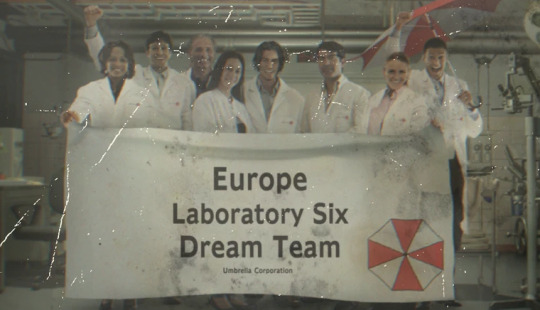
But they’re still a whole lot cleaner than, say, Luis’, considering that he was a key member of the science teams at both Umbrella Europe and in Saddler’s cult, and I don’t see him getting a fraction of the same hate as Mia. They both regret what they’ve done, and they’re both willing to give their own lives to make up for it. No, Luis never lied to a spouse about it (that we know of), but he's every bit as shifty and secretive. And frankly, most of the other shit that gets dumped on Mia’s doorstep is just as much bullshit (like, people do realise the “Mia” we see having “marital problems” with Ethan at the start of RE8 isn’t Mia, right?) But that’s material for other posts.
We don’t know how Mia got involved with the Connections, or how she felt about working for them, because the games never give us this information, and that’s a real shame. But in the capitalist hellscape we’re all living in, she’d hardly be the first to find herself stuck working for truly terrible people, one way or another.

Meanwhile, everything we see her doing during the outbreak on the tanker speaks to a basically good person, desperately trying to run damage control in a fucked-up situation. She tells Alan she’s not going to let him die, even though what’s going down is his fault. She tries so hard to talk Eveline down. After she’s rescued by the Bakers in the Daughter's DLC, she insists on staying in the trailer, meaning to leave at her first opportunity – pretty significant, considering she knows she’s infected already. She also leaves them a message warning them to stay away from Eveline, even sharing information on how to make a serum if they are infected. If you pick her over Zoe on the dock, the first thing she does is try to convince Zoe to come with them anyway. Even under Eveline's mind control, you'll catch her ranting about needing to contain the outbreak, blaming herself, and telling Ethan she loves him with her last breath.

And after being infected herself, the first thing on her mind is to try and protect Ethan, recording that message admitting she’s lied to him, and warning him to stay away (Ethan never gets that message, but you can’t say Mia didn’t try). Mia loves Ethan enough to die to save him – and she will, if you choose the Zoe path, and she’ll do it without a second thought.
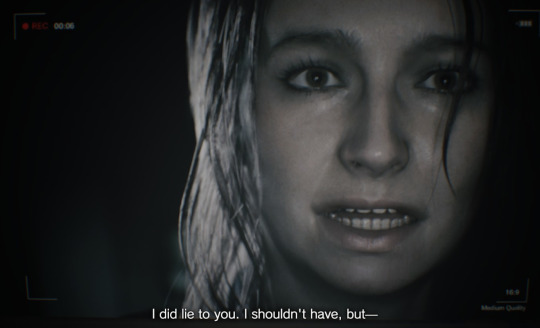
Mia is fascinating to me as a character because she’s so full of contradictions: a woman who leaves syrupy video messages sending ‘tons of kisses’ to her husband, but who is completely comfortable running around with a machine gun killing mould-monsters, and who shrugs off an Eveline jump-scare with 'fucking hallucinations!' Someone who’s done bad things and knows it, and is trying so hard to make up for it, but whose background and motivations are left frustratingly undeveloped. But if you haven’t caught that Ethan and Rose mean more to her than anything, you really haven’t been paying attention.
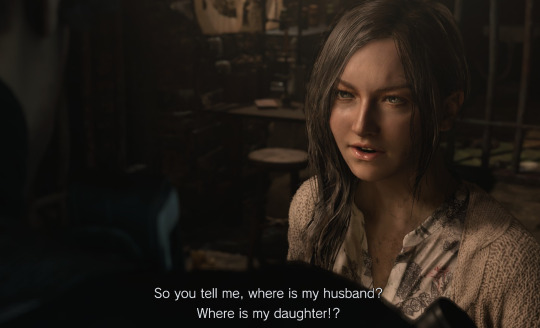
Whatever you assume about Mia’s full story, she’s complicated in a way that makes her so much more interesting to me than most of the franchise’s more popular playable characters. I am very serious in saying I want RE9 to be just the full Mia-Winters-story, because to me that’s the only remotely satisfying justification for keeping her such a mystery for so long. I know that's not at all likely, but fuck it, I can dream.
Mia’s made her share of mistakes, but holding her responsible for everything the Connections has ever done is no kind of fair.
#Mia Winters#Resident Evil Village#Resident Evil 7#Mia Winters week#The Connections#RE lore#Mia is THE BEST character I WILL FIGHT YOU ALL
143 notes
·
View notes
Text
Creator's Guide to Comics Devices: November 2023 Update
The first newsletter since launch came out a few days ago! It summarises all the updates I've made in November, which includes 2 (!) new devices, a sub-device, and other site changes.
Subscribe to the newsletter to get these updates direct to your email.
New Devices:
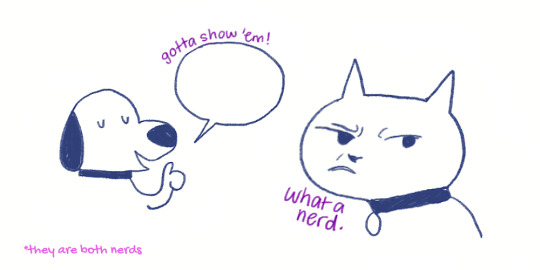
Aside
A short comment that sits outside of a balloon or character that is not perceived by anyone except the comment maker and the reader. An aside may come from the author, usually placed outside of the panel or near the edges. (Page with examples)
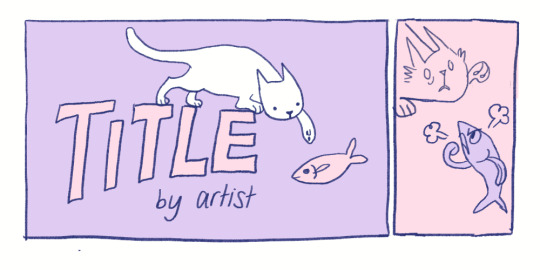
Topper
A secondary row of panels or single panel that goes 'on top' of the main comic. They are typically removable and non-essential, and usually contain the comic's title. (Page with examples)
Sub-device
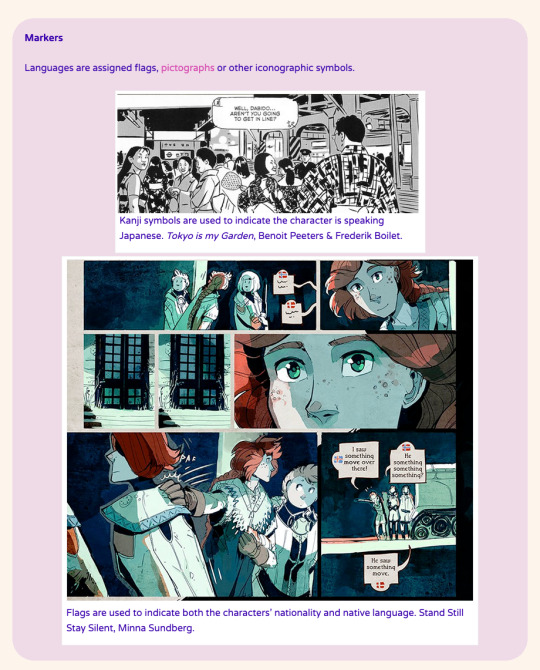
Markers in Code Switch
Languages are assigned flags, pictographs or other iconographic symbols. (Page with examples)
News from the Curator and Site Changelog
I'm delighted over how well-received the library has been -- thank you to everyone who has shared, commented and provided feedback! I really appreciate the enthusiasm and generosity. <3 As a comics creator taking my first formal steps into the arena of comics studies, there is still a lot to do and to read for the library. Even with 63 devices catalogued, it's only still the beginning!
From the Interwebs
‘The Creator’s Guide to Comics Devices’ Is the First of Its Kind, an Incredible Resource for Comics Creators & Readers Alike (The Mary Sue, Joan Zahra Dark) Lovely roundup from my fellow Cartoonist Cooperative co-founder Joan setting the historical context for Comics Devices and why an accessible resource is like this is due.
Kibbles n Bits (Comics Beat, Heidi MacDonald) An enthusiastic feature of the library in Heidi's roundup.
Shout Outs
Thank you to Ritesh, Tan Juan Gee, Samantha Philipps, Blue Dellinquanti, Ted Anderson and Hannah Pallister for their contributions. (I really need to get that credits/curator's notes page set up. That's this month's to-do) Once again, thank you to the Sequential Artists Workshop Teaching Fellowship for supporting the development of the library this month.
Updates to the Site (Nov 2023)
Added the Store page and dedicated a subsection for it on the homepage, if only to direct people to the already-existing zine that’s currently distributed by Sequential Artists Workshop and myself. I might use that page to hold things like signing up for workshops and panels if they ever happen. Added the Newsletter page so it’s easier to link to across the site and elsewhere. Opened up the page that displays all the devices on one page. Added ‘Contribution’ ‘Newsletter’ ‘All Devices’ to the sidebar. Fixed the 404 page. It suggests the Site Map for advice. Finally opened the Links page! Check out all the resources in there! Thank you to folks who have submitted feedback/contribution! I have added new example pages for Harmonious Juxtaposition/Time & Space/Pictorial Lettering/Colour Coding and a longer definition for Map Panel. Added two new devices – Aside and Topper. Added ‘Markers’ and ‘Balloon Styles’ as a subdevice to Code Switch. Finally set up the Gallery page: this is where comics pages featuring the relevant device will be catalogued. Now for the slow work of filling up the galleries…..
New in Store: The Comics Devices Quick Reference Zine Before the website launched, I produced this zine as a promotional thing + quick reference. This is a 12-page zine showcasing the devices in this library as of 2023 (not including the Topper and Aside). Perfect for students, teachers and anyone who needs a quick, in-person reference if there's no wi-fi available. Sequential Artists Workshop is selling copies for North Americans in their online store. Folks in Australia, New Zealand and Malaysia can directly contact me to get a copy. An ebook version is on the way. I will announce it via newsletter.
99 notes
·
View notes
Text
Training Your Cat

Training Your Cat: A Comprehensive Guide to Feline Behavior
Cat training differs significantly from dog training methods. Cats are independent creatures and rarely perform actions solely to please their owners. They often require motivation or a personal interest to comply with commands.
This guide provides valuable insights and strategies for successfully training your feline friend. It covers essential topics to help you understand and communicate effectively with your cat:
Cat training fundamentals
Understanding feline behavior and psychology
Proper discipline techniques
Utilizing available resources for training
Ensuring your cat's safety
Addressing biting and scratching issues
Litter box training techniques
Consequences of not training your cat
By following the strategies outlined in "Training Your Cat," you'll develop a stronger bond with your feline companion and create a harmonious living environment. This guide is an invaluable resource for both new and experienced cat owners looking to enhance their relationship with their pets.
This product is provided without a specific license. Please use the information responsibly and in accordance with applicable laws and regulations regarding pet care and training.
LINK EBOOK
#ebook#digital painting#cute cats#cat#animals#kitty#bimbo training#traininganddevelopment#course#cats of tumblr#warrior cats#catholic#cute animals
21 notes
·
View notes
Text
A brief summary of my writing
As of now, all my books are available to download on my website in many different ebook formats (as well as on Wattpad if you prefer).
So if you like reading queer fantasy and sci-fi, my offerings include:

Children of the Sun series: A sci-fi fantasy with dragons, futuristic tech and an ancient war between gods (four books, finished, currently only posted on Wattpad because I can’t put them anywhere else because of the Watties)
gay MCs
many non-white characters
grumpy man dating a ball of sunshine
a complex plot with many POVs
dragons, flying cars and swordfights

Kingdom of Dragons series: A fantasy novella series about a human kingdom taken over by tyrannical dragons (eight novellas written out of probably twenty or more)
gay MCs
bitesized self-contained adventures with overarching character development

The Curse of Magic trilogy: A fantasy with elves and humans living in a world largely taken over by a dangerous, magical jungle (two books of three written)
an aroace main character
a grumpy idiot dating a trans elven wizard (in book 2)
a fully non-white cast
dual POV

Wings of Gold series: A fantasy gay romance novella series about a human thief and a dragon falling in love (two books of six written)
gay MCs (obviously)
eventually will have polyamory and enemies to lovers
relatively short - both books around 40K words and I assume the trend will continue
relatively low, personal stakes

Nightstar trilogy: A fantasy series about two countries at war and people with nature-based powers (prequel and 2 books of 3 written)
gay MCs dating each other (one controls shadow, the other light, for delicious symbolism)
queer cast (including a nonbinary character)
best worldbuilding of all my series (especially with how the powers work and are utilized)
dual POV (with ocassional guest POV)

Penned Sea Hearts: A standalone cozy fantasy (romance) about an asexual merman librarian and a famous merman author who takes a liking to him
asexual rep
dual POV
relatively short (cca 37K words)
fun worldbuilding - the whole thing takes place underwater
comfily low stakes

Nightfall trilogy: An urban fantasy series about demons, vampires, angels, all the good stuff (book 1 written, this one is on the back burner)
gay MCs
a will they won't they (even the author doesn't know)
demons aren't necessarily bad/angels aren't necessarily good/they're both creatures from other dimensions
god doesn't exist we don't talk about him

Erina's Guide to Grinding Gears: A standalone explicit steampunk romance about an amputee engineer and his technician girlfriend who he's obssessed with.
BDSM (naturally the guy subs)
novella (27K words)
fun use of corsets
shockingly there is some plot among all the sex

Worlds Apart: A standalone about two elves, old friends turned enemies, getting stuck in Prague. Now they have to work together to get home. Written for the Open Novella Contest 2025
transman main character
novella (20K words)
single POV
some fun technomagic stuff
elves have big, moving ears and tails

Scorched Earth: A standalone about superheroes and supervillains. Written for the Open Novella Contest 2024
gay main characters who are also supervillains (kinda)
novella (22K words)
dual POV
some of my best dialogue

Starfall: a romantasy standalone about a star dragon who falls to the earth and a man with a dark past who finds him
two gay couples
short novel (65K words)
much romance, many cute
ocassional BDSM sex scene
a god-like being who is a certified creature
#writeblr#writers of tumblr#amwriting#original writing#children of the sun series#nightfall series#nighstar series#penned sea hearts#wings of gold series#curse of magic series#kingdom of dragons series#free books#shameless promo#my writing#my books#scifibooks#scififantasy#fantasy books
138 notes
·
View notes
Text
I was at the library yesterday, which is now my go-to for distractionless work; I uploaded Dinner At The Palace with a few last edits so it's ready to go in print and epub, wrote all the sales copy, and updated my website with "coming soon" announcements. Wordpress really is just the worst; I can code what I want in about a third of the time it takes to tell Wordpress what I want and even then it fucks it up. It's like working with Word if it were designed by a toddler who hates me, personally. I'm building a new site on another platform, which is not much better but does allow me to copy, paste, or delete a block of text by selecting said text, something Wordpress's feeble grasp on structure is still grappling with. As we have daily proof. *gestures at Tumblr*
Anyway, I've been thinking about overhauling the older novels, standardizing them into the style guide I've developed. So I dug out all the upload files for Nameless, my first novel, and cracked them open just to see what kind of work it would take.
The document file for Nameless is so old that Windows wasn't sure how to open it. I mean it was just a .doc file and Windows likes to give you options when it's not a .docx, but I was still amused that I had to tell it how to get into the Ancient Tome. This was also before ebooks were as big as they are now, especially in indy publishing; these days you can just upload a word document and Lulu will convert it, but back in 2009 I had to create an HTML file of my novel to get it converted to ePub. Wild.
The bad news is that my early documents for my first few novels are a brutal mess, but the good news is that because I was less sophisticated in terms of how to typeset, they're also very simple and easy to upgrade, and even back then I was saving the covers as psd files, so it's all editable. I'd rather finish Royals/Ramblers than work over all my old manuscripts, but they're a nice break when I'm tired of other work.
Now I just have to determine if I have the emotional stability to re-read Nameless. It was a very personal novel to me, but it was also published almost 15 years ago, and I'm a little concerned about being able to read my deathless 2009 prose without wincing. I tell myself we all learn and grow, and Christopher and Lucas aren't real and won't suffer if I wrote them poorly, but I'm still bracing myself for all that.
125 notes
·
View notes
Text

"One of the finest of his generation of critics"—Kieron Gillen (Die, The Wicked + The Divine) Fifty-two essays composing the very best of veteran video game developer and writer Mathew Kumar's "Every Game I've Finished" project, published for the first time in print with commentary from the author. Releasing October 21st, 2024 in print, and available for pre-order now for Kindle or as epub/pdf. Games covered include legendary icons (Wizardry: Proving Grounds Of The Mad Overlord), indie darlings (Papers, Please), beloved obscurities (Attack of the Friday Monsters!), Triple-A franchises (Mass Effect) and modern classics (The Legend of Zelda: Breath of the Wild). Essays take the form of everything from straight critique to strategy guide, and represent an overview of the state of the art in video games across its history distilled into ten years of highs and lows. A book that takes video games as seriously as any art form and as deserving of collected criticism. “Mathew’s project, to finish the games he plays, and to write about those he finishes, can be simply stated but it represents a noble act of critical commitment. When taken in concert, these reviews –– unflinchingly acerbic, truthfully stated, and deeply unconcerned with external factors of fashion or consensus –– provide both a diary of criticism, and a long view of the judders and lunges of this still-evolving medium; A charter, too, for what we might cherish, and what we might disdain, in this emergent art form.”–Simon Parkin (A Game of Birds and Wolves, Death By Video Game)
---
Phew! When I announced exp. 2601 I mentioned it was the ten year anniversary of Every Game I've Finished in 2024 and that it might be important, and here it is, a celebration of my last ten years of writing that you can buy as a book that you can own in your house. I didn't originally plan it this way! I intended to release Every Game I've Finished 14>24 as a (somewhat) quick and dirty ebook release, and I did the majority of the work at the beginning of the year pre-exp. 2601, but after realising it would only take a "little" more work to self-publish the book physically I decided if I was going to vanity press, I might as well do it for real.
Of course, it's taken a lot longer than I expected, but I finally have a proof in my hand that I'm satisfied with, and it really does look very nice.
Vanity press or not, there are a few vectors to this release. Firstly, if you've ever enjoyed any of my writing of the past ten years, here's a nice way to support me and either get a lovely physical or handy digital edition. Secondly, if you haven't, here's a way to immediately get fifty-two of the best articles I've written which you can peruse at your leisure.
Thirdly, I just honestly think that there should be a culture of criticism around games just as there is for literally every other art form, and I think that this book existing makes as much sense as, say Clive James On Television, so I'm just fucking going for it.
That all said, Every Game I've Finished 14>24 is being released on October 21st 2024, and is being released in print on Amazon. I'm no happier about this than you are, but it's the simplest method. I would love to offer copies here on Ko‑fi for launch day, but they (sneakily) give author copies a long lead time and (of course) it's impossible to compete with Amazon's postage rates.
Amazon also--for bafflingly unclear reasons--won't allow me to offer a pre-order of the print edition, so please mark the date in your calendar or follow me on Bluesky or (spit) Twitter if you want to get a copy.
However! If you're just looking for the ebook, you can pre-order it on Kindle or epub/pdf right now! Subscribers will receive their shop discount on the digital edition, so don't forget you can support me for just $1 a month. This release has been, and I know it's a cliche, a real labour of love, just as Every Game I've Finished has been a labour of love for video games (even if it doesn't always read like it.) I can't wait for you to get your hands on it, and I'm so thankful for all of you who have joined me on this journey.
#gaming#video games#games#txt#text#announcement#book#every game i've finished 14>24#mathew kumar#print#epub#pdf#kindle
12 notes
·
View notes
Text
For those interested: Joe Murray, creator of Rocko's Modern Life and Camp Lazlo, has released his 2010 book "Creating Animated Cartoons with Character: A Guide to Developing and Producing Your Own Series for TV, Web or Film" as a FREE eBook download on his website! It can be found here: https://joemurraystudio.com/books-by-joe-murray/
It is a straight download - no info input required, Murray simply asks you make a donation to a food bank or otherwise pay it forward. This book is since out of print and sells for astronomical prices online so for people (especially like me!) interested in animated TV development this is an AMAZING resource!
Here is the full page blurb for the download copied directly from Murray's site:
This book is one creators approach to creating and producing an animated series. Packed with details and lessons learned from producing Rocko’s Modern Life and Camp Lazlo, along with many side anecdotes. Also included are interviews with the late Stephen Hillenburg (Spongebob) Craig McCracken ( Powerpuff girls) Tom Kenny ( voice of Spongebob and Heffer), and many more professionals discussing their craft. The book has since gone out of print, and many resellers are taking advantage of a wanting audience by selling copies at an immense profit. I have received many letters from those who cannot afford these prices and feel they could benefit from the information here. Even though some of the streaming and broadcast information are a bit out of date,( and Lets Go Luna is not included here) much of the info is still relevant. So I am offering a digital copy for you as a free download. As payment, maybe you can donate to a food bank, or simply pay it forward somehow. I am working on a new book about story and character for animation. We will see how it goes. I hope this book can be of service to you. Enjoy!
#joe murray#rocko's modern life#camp lazlo#artist resources#animation resources#story resources#character design resources#artists on tumblr#cartoon#cartoonist#animation#character design
71 notes
·
View notes
Text
Queer Liberation Ecopunk Fantasy with Lovable Cast, Slow-Burn Romance, and a Scary Deadly Gryphon
Hey Tumblr! I am a queer indie fantasy author and I think you're gonna LOVE my next book. If you're pissed about politics, this is the perfect fantasy that touches on some of the fascist ways queer folks are being targeted, with a cozy bow on top... if that makes sense.
Call Forth the Moonlight: A Magiqon's Guide to Gryphon Liberation stars Nico and Ackerleigh, two people leading very different lives in the country of Deubrise. Their fates become intertwined by the imprisoned gryphon Lux, and Nico and Ackerleigh fall for each other while they risk everything to secure Lux's freedom.
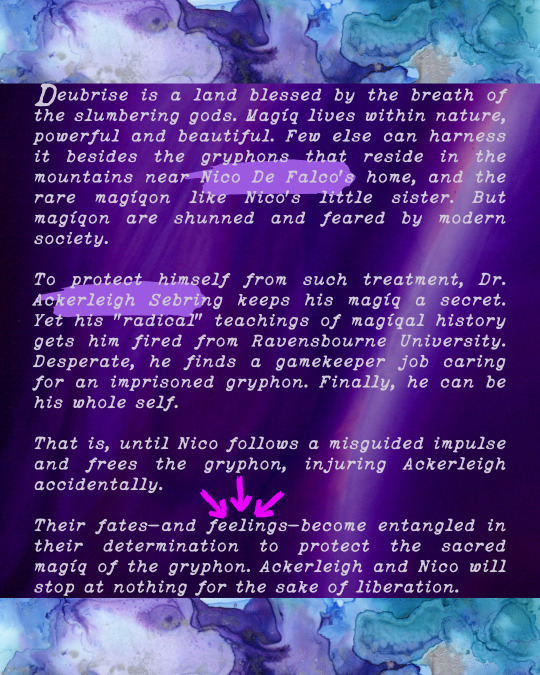
Did you know? You can sign up for a free ARC through BookSprout.
But that's not all. Literally, things are amping up as the April 4th release date nears.
Right now, you can head to my website and pre-order a paperback of CFTM which will come directly from me and include exclusive handmade goodies. You can also get your hands on some exclusive short stories by pre-ordering the ebook.

I'm telling you, this might be my favorite story from the last like, decade. Nico and Ackerleigh have really shaped into awesome, loving, and well-developed protagonists with the best neurodivergent rep I've ever done on purpose. The people around them supporting them are well-rounded and could be dropped into any of our lives and fit right in. They're allies at all points in their journeys showing up for the people they love. They're other queer folks, some of them brainy, others young, others old, others curvy, others being victims of abuse.
Ackerleigh and Genderqueerness
One of the most exciting things about this book is when I decided last June that Ackerleigh was genderqueer. He's not a twink, he's not a femboy, he's genderqueer. Plain and simple. He loves delicate fabrics and is a small, ethereal man who does NOT identify as a twink, and doesn't want to be treated like he's fragile or demure. He's a bold, opinionated, and dominant personality. Ackerleigh identifies as a man, to a degree, but does not want to be constrained by masculinity. He can be soft AND masculine. He can be small AND dominant.
The boys and neurodivergence
As the drafts of CFTM developed, both boys emerged as strongly neurodivergent. Ackerleigh definitely has ADHD and autism whereas Nico is strongly autistic and has C-PTSD.
Ackerleigh is 27 at the time of the story and has his PhD, following the sort of single-minded determination as someone pursuing all the information they can in their special interest to an obsessive degree. He is routine-oriented and not highly social, but highly curious and at times impulsive or easily distracted or else extremely hyper-focused. One of Ackerleigh's most noticeable stims is rubbing his knuckle over his lip. He can have a short temper especially if his train of thought is interrupted or he can't complete a part of his routine. When agitated, his sleep schedule goes out the window and he is known to pace obsessively to the extent that he wears noticeable tracks in his floor.
Nico is 25 at the time of the story. He lacks any sort of grounded dreams for himself, something that I borrowed from my autistic husband - it's not from thoughtlessness or lack of personality, but from feeling like there's nowhere that you can quite fit and a significant lack of confidence in your own abilities. Nico is very sensitive to rejection and has many sensory sensitivities including being around too many people, wearing uncomfortable or scratchy fabrics, and having his hands or clothing wet or dirty. Nico also stims on his scar when he's nervous partly because he gets triggered and thinks back to when his sister nearly killed him accidentally and partly because he likes the smooth texture of the scar on his fingertip. Nico also experiences selective mutism when he's stressed and engages in head-hitting at times especially if he's angry at himself. Nico is overly apologetic and is quick to offer to fix his errors since he always assumes the error is his.
Anyway, Thanks for staying with me for this long post and I hope you fall in love with Call Forth the Moonlight like I have!
#writerblr#readers#queer fiction#queer author#queer artist#genderqueer#genderqueer protagonist#neurodivergent#neurodiversity#gryphon#gryiffin#fantasy creature#fantasy creatures in books#fantasy books#fantasy author#queer fantasy#ownvoice neurodivergent#ownvoice genderqueer
4 notes
·
View notes